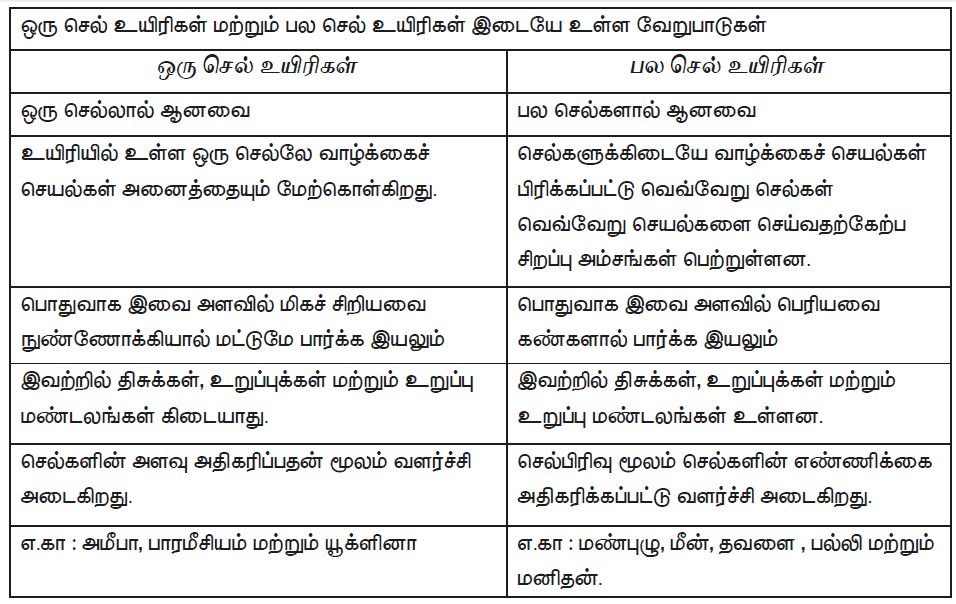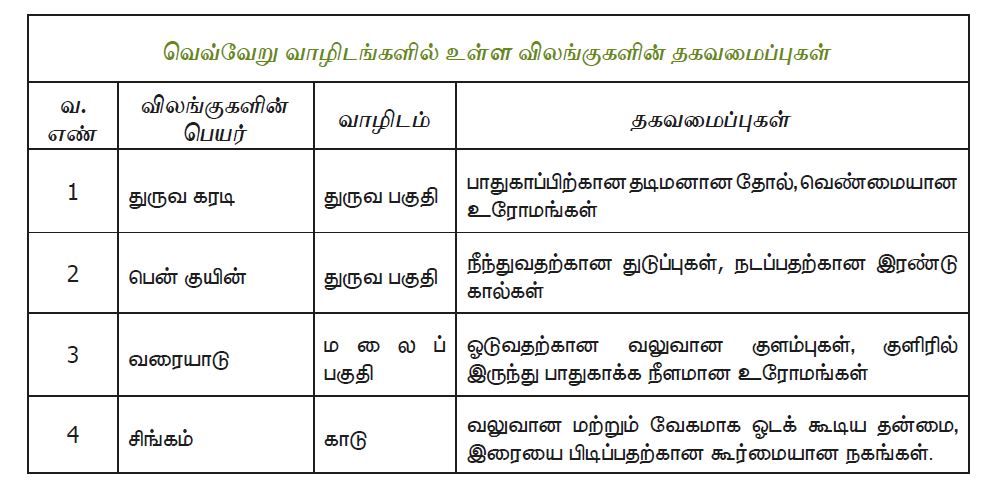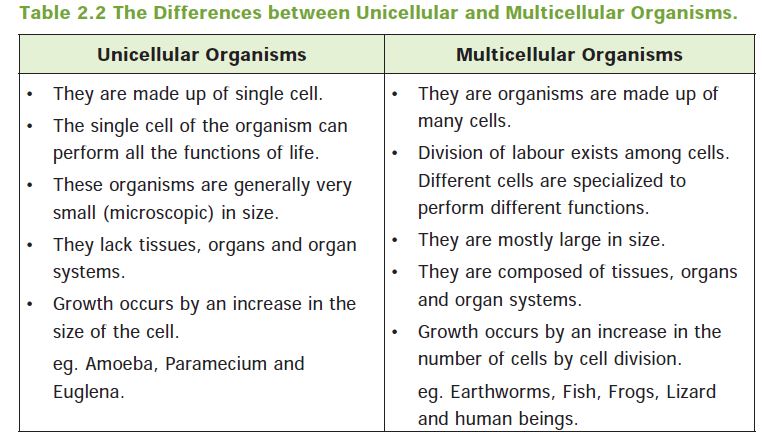பாடத் தலைப்பு : விலங்குகள் வாழும் உலகம் LIVING WORLD OF ANIMALS
PDF டவுன்லோட் செய்ய : இந்த குறிப்புகள் அனைத்தையும் PDF வடிவில் டவுன்லோட் செய்துகொள்ள விரும்புபவர்கள், கீழே உள்ள தேர்வை ATTEND செய்யவும். தேர்வை முடிக்கும் பொழுது உங்களுடைய மதிப்பெண்ணுடன் PDF டவுன்லோட் செய்வதற்கான லிங்க்கும் காட்டப்படும். அதனைக் கிளிக் செய்து PDF டவுன்லோட் செய்து கொள்ளவும்.
இந்த இயலில் மொத்தம் 22 குறிப்புகளும் அவற்றைக் கொண்டு உருவாக்கப்பட்ட 25 கேள்விகளும் உள்ளன.
இந்தத் தேர்வு குறிப்புகள் குறித்த உங்களின் கருத்துக்களை கீழே உள்ள கமெண்ட் பாக்ஸில் தெரிவிக்கவும்
இதற்கு முந்தைய தேர்வினை எழுத கீழே கிளிக் செய்யவும்
தேர்வு - கேள்விகளின் எண்ணிக்கை 25
Results
வாழ்த்துகள். நீங்கள் இந்தத் தேர்வில் தேர்ச்சி பெற்றுள்ளீர்
மீண்டும் இதே தேர்வினை எழுதுவதற்கு கீழே கிளிக் செய்யவும்
அடுத்த தேர்விற்கு செல்ல கீழே கிளிக் செய்யவும்
இந்தக் கேள்விகள் அனைத்தையும் PDF வடிவில் டவுன்லோட் செய்து கொள்ள விரும்புபவர்கள் கீழே கிளிக் செய்யவும்
Tamil Medium Notes – Click here
English Medium Notes – Click here
இந்தக் கேள்விகள் உங்களுக்குப் பிடித்திருந்தால் எங்களைப் பாராட்டுவதற்கு கீழே உள்ள ஏதேனும் ஒரு விளம்பரத்தைக் கிளிக் செய்யவும்.
நீங்கள் இந்தத் தேர்வில் தேர்ச்சி பெறுவதற்கான மதிப்பெண்களைப் பெறவில்லை.
மீண்டும் இதே தேர்வினை எழுதுவதற்கு கீழே கிளிக் செய்யவும்
அடுத்த தேர்விற்கு செல்ல கீழே கிளிக் செய்யவும்
இந்தக் கேள்விகள் அனைத்தையும் PDF வடிவில் டவுன்லோட் செய்து கொள்ள விரும்புபவர்கள் கீழே கிளிக் செய்யவும்
Tamil Medium Notes – Click here
English Medium Notes – Click here
இந்தக் கேள்விகள் உங்களுக்குப் பிடித்திருந்தால் எங்களைப் பாராட்டுவதற்கு கீழே உள்ள ஏதேனும் ஒரு விளம்பரத்தைக் கிளிக் செய்யவும்.
#1. கருத்து 1 : பல்லிகள் செவுள்கள் மூலம் சுவாசிக்கின்றன. Statement 1:Lizards breathe through Gills. கருத்து 2: பல்லிகளின் பற்களில் காணப்படும் நீட்சி பகுதிகள் இரையை இழுத்துப் பிடிக்க பயன்படுகிறது. Statement 2:Lizards have sharp, tricuspid, teeth adapted for grabbing and holding
#2. பாரமீசியம் எதன் மூலம் இடப்பெயர்ச்சி செய்கிறது Paramecium using __________ for locomotion
#3. கோடைக்கால உறக்கம் பின்வருவனவற்றுள் எதில் காணப்படுகிறது Aestivation is a common practice in
#4. பின்வருவனவற்றுள் எது இருமை பார்வை திறன் கொண்டது Which of the following has binocular vision
#5. கருத்து 1 : பாரமீசியம் நீரில் வாழும் ஒரு செல் உயிரி. இது தன்னுடைய கசையிழையின் மூலம் இடப்பெயர்ச்சி செய்கிறது. Statement 1:Paramecium is also a unicellular organism which lives in water and moves with the help of flagellam. கருத்து 2: அமீபாவில் சுருங்கும் நுண் குமிழ்கள் மூலம் கழிவு நீக்கம் நடைபெறுகிறது. Statement 2: In amoeba Contractile vacuoles help in excretion.
தேர்வு எழுதி முடிக்கும் பொழுது உங்களுடைய மதிப்பெண் மற்றும் PDF டவுன்லோட் செய்வதற்கான லிங்க் காட்டப்படும்
அடுத்து தேர்விற்கான பாட குறிப்புகளை காண கீழே கிளிக் செய்யவும்
எங்கள் இணையதளத்தில் 6-ஆம் வகுப்பு முதல் 12-ஆம் வகுப்பு வரை உள்ள அனைத்து பாடங்களுக்குமான ஒரு வரி குறிப்புகள் அனைத்தும் பாடவாரியாக பதிவேற்றம் செய்யப்பட்டுள்ளது.
ஒவ்வொரு பாடத்திலிருந்தும் எடுக்கப்பட்ட குறிப்புகளை கொண்டு தயாரிக்கப்பட்ட தேர்வும் (TEST) கீழே கொடுக்கப்பட்டுள்ளது. குறிப்புகள் அனைத்தையும் படித்துவிட்டு அந்த தேர்வை எழுதிப் பார்க்கும் வசதியும் அளிக்கப்பட்டுள்ளது.
ஒருவரி வினாக்கள் அனைத்தும் பாடப்புத்தகத்தை வரி வரியாகப் படித்து எடுக்கப்பட்டதாகும்.
இந்தத் தொகுப்பில் உள்ள அனைத்து வினாக்களையும் நீங்கள் முறையாக பயிற்சி செய்தாலே தமிழகத்தில் நடைபெறும் அனைத்து வகையான போட்டித் தேர்வுகளிலும் வெற்றி பெறலாம்.
இது போன்று அனைத்து பாடங்களுக்குமான, வரி வரியாகப் படித்து எடுக்கப்பட்ட வினாக்களை பெற கீழே உள்ள டெலிகிராம்/ வாட்சப் குரூப்பில் இணைந்து கொள்ளவும்.
Telegram : https://t.me/THAMIZHPRIYANKALVI1
Whatsapp : https://chat.whatsapp.com/CAJ20fhIAwEHEmeagezQBS
youtube channel : https://www.youtube.com/c/ThamizhpriyanKalvi
Website: http://tpnkalvi.in/
வரி வரியாகப் படித்து எடுக்கப்பட்ட ஒரு வரி குறிப்புகள்
- உயிரினப் பல்லுயிர் தன்மை என்பது காடுகளில் மற்றும் வீடுகளில் வாழும் விலங்குகளின் சிற்றினங்களின் எண்ணிக்கை, உயிர்த்தொகை உயிரியல் சமூகம் மற்றும் சூழ்நிலை மண்டலங்களால் ஆனது. மேலும், பல்வகைத்தன்மை என்பது, உயினங்கள் வாழும் பல்வேறு வாழிடங்கள் மற்றும் அவை பெற்றுள்ள பல்வேறு மாறுபாடுகளையும் குறிப்பிடுவதாகும்.
- உயிரினத்தின் மிகச் சிறிய செயல்படும் அலகு செல்கள் ஆகும். இந்த உயிரினங்களின் உடலில் நடைபெறும் அனைத்து செயல்களும், செயல்பாடுகளும் இந்த நுண்ணிய செல்களின் மூலமாக செயல்படுத்தப்படுகிறது.
- ஒரே செல்லால் ஆன சில உயிரினங்கள் ஒரு செல் உயிரிகள் எனவும், பல செல்களால் ஆன உயிரினங்கள் பல செல் உயிரிகள் எனவும் அழைக்கப்படுகின்றன.
௭.கா - ஒரு செல் உயிரிகள் - அமீபா பாரமீசியம் மற்றும் யூக்ளினா
பல செல் உயிரிகள் - மீன், தவளை, பல்லி, பறவை மற்றும் மனிதன் - சிங்கப்பூரில் உள்ள ஜீராங் பறவைகள் பூங்காவில், பென்குவின் பறவைகள் பனிக்கட்டிகள் நிரம்பிய ஒரு பெரிய கண்ணாடி கூண்டுகளில் 0 டிகிரி செல்சியஸ் வெப்பநிலை அல்லது அதற்கும் குறைவான வெப்பநிலையில் பராமரிக்கப்படுகின்றன.
- ஒரு செல் உயிரினங்கள் என்பவை வெறும் கண்களால் பார்க்க முடியாத நுண்ணோக்கியால் மட்டுமே பார்க்கக் கூடிய மிகச் சிறிய உயிரினங்கள் ஆகும்.
- ஒரு செல் உயிரினங்கள் நீரில் வாழும் தன்மை கொண்ட, எளிய மற்றும் விலங்குகளிலேயே மிகவும் முதன்மையான உயிரினங்கள் ஆகும்.
- ஒரு செல் உயிரினங்களில் பல்வேறு உடற்செயல்களை செய்வதற்கு சிறப்பு அமைப்புகளாக உடல் நுண்ணுறுப்புகளை பெற்றிருக்கின்றன.
- அமீபா
- ஓர் ஒரு செல் உயிரி.
- உணவு செரித்தல், இடப்பெயர்ச்சி, சுவாசித்தல் மற்றும் இனப்பெருக்கம் ஆகிய அனைத்து செயல்பாடுகளையும் மேற்கொள்கிறது.
- நீரில் இருந்து உணவை விழுங்குகின்றன.
- உணவு, உணவுக் குமிழி மூலம் செரிமானம் அடைகிறது.
- சுருங்கும் நுண் குமிழ்கள் மூலம் கழிவு நீக்கம் நடைபெறுகிறது.
- எளிய பரவல் முறையில் உடலின் மேற்பரப்பின் வழியாக சுவாசித்தல் நடைபெறுகிறது.
- விரல் போன்ற நீட்சிகளான போலிக்கால்களைப் பெற்றுள்ளன. இதன் மூலம் இடப்பெயர்ச்சி செய்கின்றன.
- பாரமீசியம் நீரில் வாழும் ஒரு செல் உயிரி. இது தன்னுடைய குறுஇழைகள் மூலம் இடப்பெயர்ச்சி செய்கிறது.
- ஒரு செல் உயிரியான யூக்ளினா, கசையிழையின் மூலம் இடப்பெயர்ச்சி செய்கிறது.
- தாவரங்கள் மற்றும் விலங்குகள் ஒரு குறிப்பிட்ட வாழிடத்தில் வாழ்வதற்கேற்பத் தங்கள் உடலில் பெற்றுள்ள சிறப்பு அமைப்புகள் தகவமைப்புகள் என்று அழைக்கப்படுகிறது.
- மீன்
- மீனின் தலை, உடல் மற்றும் வால் ஆகியவை இணைந்து படகு போன்ற வடிவத்தை தருகின்றன.
- மீனின் படகு போன்ற உடல் அமைப்பு அது நீரில் எளிதாகவும், வேகமாகவும் நீந்த உதவுகிறது.
- மீனின் சிறப்பு உறுப்பான செவுள்கள் சுவாச உறுப்பாகும். இது நீரில் கரைந்திருக்கும் ஆக்ஸிஜனை உறிஞ்ச அல்லது எடுத்துக் கொள்ள உதவுகிறது. இது நீரில் சுவாசிப்பதற்கானத் தகவமைப்புகளை பெற்றுள்ளது.
- பெரும்பாலான மீன்களின் உடல் முழுவதும் வழுவழுப்பான செதில்கள் காணப்படுகின்றன.
செதில்கள் மீனின் உடலை பாதுகாக்கின்றன. - மீன் துடுப்புக்களைப் பெற்றுள்ளன.
- உறுதியான வால் துடுப்பானது திசை திருப்புக் கட்டை போன்று செயல்பட்டு, மீன் திசை திரும்பவும், நீரில் அதன் உடல் சமநிலை பெறவும் உதவுகிறது.
- பல்லி
- பல்லிகள் செதில்களால் ஆன தோல் அமைப்பைக் கொண்ட ஊர்வன வகையைச் சார்ந்தவை.
- இவை, கால்கள், அசையும் கண் இமைகள், கண்கள் மற்றும் வெளிப்புறக் காது திறப்பு ஆகியவற்றைப் பெற்று பாம்புகளிலிருந்து வேறுபடுகின்றன.
- இவை பெரும்பாலும் வெப்பமண்டல பகுதிகளில் வாழக் கூடியவை.
- பெரும்பாலான பல்லிகள் நான்கு கால்களால் நடக்கக் கூடியவை, இவற்றின் கால்கள் வலிமை வாய்ந்தவை.
- சில பல்லிகள் தலை இணைப்பு மூலமாக தலையைமுழுமையாக சுழற்றும் தன்மையைக் கொண்டவை.
- பல்லிகள் நுரையீரல்கள் மூலம் சுவாசிக்கின்றன.
- பெரும்பாலான பல்லிகள் பூச்சி வகைகளைச் சார்ந்த கொசு மற்றும் கரப்பான் பூச்சி போன்ற பூச்சிகளை உண்ணுகின்றன.
- பற்களில் காணப்படும் நீட்சி பகுதிகள் இரையை இழுத்துப் பிடிக்க பயன்படுகிறது.
- சில பல்லிகள் இரு கால்களில் ஒடக் கூடியவை.
- இவ்வாறு இரு கால்களில் ஓடும் போது பல்லியின் வாலானது அதன் முழு உடல் எடையை தாங்கும் வகையில் பின்நோக்கி இருக்கும் அல்லது மேல் நோக்கி இருக்கும்.
- சில பல்லிகளுக்கு (டயனோசார்) கால்களில் விரலிடைச் சவ்வுகள் உள்ளன.
- சில பல்லிகள் பறக்கும் தன்மையும், பாதுகாப்புடன் தரையிறங்கக் கூடிய தன்மையும் பெற்றுள்ளன.
- பல்லிகள் செதில்களால் ஆன தோல் அமைப்பைக் கொண்ட ஊர்வன வகையைச் சார்ந்தவை.
- பறவைகள்
- பறவைகள் இறகுகளால் மூடப்பட்ட, படகு போன்ற உடல் அமைப்பை பெற்றிருக்கின்றன.
- படகு போன்ற உடல் அமைப்பு குறைந்தபட்ச எடையுடன் காற்றில் பறக்கக் பயன்படுகிறது.
- பறவைகளுக்கு வாய்க்கு பதிலாக அலகுகள் உள்ளன.
அவை நுரையீரல்கள் மூலம் சுவாசிக்கின்றன. - பறவையின் முன்னங்கால்கள் இறக்கைகளாக மாறுபாடு அடைந்துள்ளன.
- உள்ளீடற்ற அல்லது வெற்றிடத்தினால் ஆன இலகுவான எலும்புகளைப் பெற்று இருக்கின்றன.
- பறவைகள் பறக்கும் தன்மை பெற்றிருப்பினும் அவற்றால் நிலத்தில் நடக்கவும், ஓடவும், குதிக்கவும் முடியும்.
- பறவைகளின் கால்களில் உள்ள கூர் நகங்கள் மரங்களின் கிளைகளை நன்கு பற்றிக் கொண்டு அமர உதவுகின்றன.
- பறவையின் வால் பறக்கும் திசையைக் கட்டுப்படுத்த உதவுகிறது.
- பறத்தலின் போது ஏற்படும் அழுத்தத்தினைத் தாங்குவதற்கு வலிமை மிக்க மார்புத் தசையினைப் பெற்றுள்ளன.
- ஒரே சமயத்தில் இரு கண்கள் மூலம் இரு வெவ்வேறு பொருட்களை பறவைகளால் காண முடியும். இதற்கு இருமை பார்வை என்று பெயர்.
- பறவைகள் இறகுகளால் மூடப்பட்ட, படகு போன்ற உடல் அமைப்பை பெற்றிருக்கின்றன.
- ஒரு விலங்கு பருவமாறுபாட்டின் காரணமாக ஓரிடத்திலிருந்து வேறு ஒரு இடத்திற்கு செல்வது "வலசை போதல்" என்பதாகும்.
- வேடந்தாங்கல், கோடியக்கரை, மற்றும் கூந்தன் குளம் ஆகிய இடங்கள் தமிழ் நாட்டில் காணப்படும் பறவைகள் சரணாலயங்கள் ஆகும்.
- பல பறவைகள் வெளிநாடுகளான சைபீரியா மற்றும் ரஷ்யாவிலிருந்து வேடந்தாங்கல் வருகின்றன. அதே போல் கோடை மற்றும் வறட்சி அதிகமுள்ள காலங்களில் நம் நாட்டுப் பறவைகள் வெளி நாடுகளுக்கு வலசை போகின்றன. எனவே இவைகள் வலசைபோகும் பறவைகள் என்று அழைக்கப்படுகின்றன.
- சில விலங்குகள் அதிகப்படியான குளிரை தவிர்க்க, அனைத்து செயல்பாடுகளையும் நிறுத்திவிட்டு உறக்கத்தில் ஈடுபடுகின்றன, இந்நிலைக்கு குளிர்கால உறக்கம் என்று பெயர். எ.கா. ஆமை
- சில விலங்குகள் அதிகப்படியான வெப்பத்தை தவிர்க்க, அனைத்து செயல்பாடுகளையும் நிறுத்திவிட்டு உறக்கத்தில் ஈடுபடுகின்றன, இந்நிலைக்கு கோடைகால உறக்கம் என்று பெயர். எ.கா.நத்தை.
- ஒட்டகத்தின் தகவமைப்புகள்
- ஒட்டகம் நீர் குறைவாக உள்ள வெப்பமானப் பாலைவனத்தில் வாழ்கின்றன.
- இதன் நீண்ட கால்கள் பாலைவனத்தில் உள்ள சூடான மணலில் இருந்து உடலை பாதுகாக்கின்றன.
- இவை நீர் கிடைக்கும்போதெல்லாம் அதிக அளவு நீரை அருந்தி, தன் உடலில் தேக்கி வைத்துக் கொள்கின்றன.
- உலர்ந்த பாலைவனத்திற்கு ஏற்றாற்போல் தன் உடலில் நீர் சேமிக்கும் தகவமைப்பைப் பெற்றுள்ளன.
- ஒட்டகம் குறைந்த அளவு சிறுநீரை வெளியேற்றுகிறது.அதன் சாணம் வரண்டு காணப்படும்.
அதன் உடலில் இருந்து வியர்வை வெளியேறுவதில்லை. - ஒட்டகம் தன் உடலில் இருந்து சிறிதளவு நீரையே இழப்பதால், அவற்றால் பல நாட்களுக்கு நீர் அருந்தாமல் உயிர் வாழ முடியும்.
- ஒட்டகம் திமில் பகுதியில் கொழுப்பை சேமித்து வைக்கின்றது. சக்தி தேவைப்படும் காலங்களில் ஒட்டகம் தன் திமில் பகுதியில் சேமித்து வைக்கப்பட்ட கொழுப்பை சிதைத்து ஊட்டம் பெறுகின்றது.
- ஒட்டகம் பெரிய, தட்டையான திண்டு கால்கள் மூலம் மிருதுவான மணலில் நன்றாக நடக்கும் தன்மையை பெற்றுள்ளன. இதனால் ஒட்டகத்தை "பாலைவனக் கப்பல்" என்று அழைப்பார்கள்.
- ஒட்டகங்களின் நீண்ட கண் இமைகள் மற்றும் தோல் அதன் கண் மற்றும் காதுகளை புழுதிப் புயலில் இருந்து பாதுகாக்கிறது.
- நாசித் துவாரங்கள் தூசிகள் உள்ளே செல்வதைத் தடுப்பதற்காக மூடிய நிலையில் காணப்படும்.
- ஒட்டகம் நீர் குறைவாக உள்ள வெப்பமானப் பாலைவனத்தில் வாழ்கின்றன.
- எப்பொழுதும் கங்காரு எலி நீர் அருந்துவதில்லை. அது உண்ணும் உணவில் இருந்து உடலுக்கு தேவையான நீரை உருவாக்கிக் கொள்கிறது.
- வரையாடு மலைகளின் மீது உள்ள பாறைகளின் இடுக்குகளில் மிக எளிதாக நுழைந்து உடல் சமநிலையுடன் ஏறி தாவர வகைகளை உண்ணும் திறன் பெற்றுள்ளது.


LINE BY LINE NOTES FOR ENGLISH MEDIUM STUDENTS
- The term biodiversity refers to the totality of species, populations, communities and ecosystems, both wild and domestic. It may also be defined as the variety and variability among living organisms and the habitats in which they live.
- Living things are made of small units called cells. All the functions and processes in the body of living things are brought about with the help of these microscopic cells.
- Some organisms are made up of a single cell and these are called unicellular organisms, whereas, the organisms that are made of many cells are called multicellular organisms. Amoeba, Paramecium and Euglena are unicellular while, fish, frog, lizard, bird and man are multicellular.
- In Jurong Birds Park, Singapore, Penguins are kept in a big glass case with ice bergs and temperature is maintained at 0° C and below.
- Unicellular organisms are small, usually microscopic, cannot be seen with naked eye.
- They are aquatic, simplest and most primitive of all animals.
- They perform all their physiological activities by the special structures present inside the body called organelles.
- Amoeba
- Amoeba is an unicellular organism
- It does all the activities like digestion, locomotion, respiration and Reproduction.
- It swallows food from the water and the food is digested in the food vacuole.
- Contractile vacuoles help in excretion.
- Respiration is by simple diffusion through the body surface.
- They have finger-like structures called Pseudopodia, (false foot) which help in movement or locomotion.
- Paramecium is also a unicellular organism which lives in water and move with the help of cilia.
- Euglena is an unicellular animal which moves with a flagellum.
- The presence of specific body features for certain habits which enable a plant or an animal to live in a particular habitat is called adaptation.
- Fish
- The head, trunk and tail of a fish merge to form a streamlined shape.
- The streamlined body shape helps the fish to move through the water easily.
- The fish has special organs called “Gills” which is a respiratory organ helps to absorb oxygen dissolved in water for breathing. It is adapted to breathe in water.
- Most of the fishes have slippery scales all over the body which protect the body.
- The fish has fins for swimming.
- The fish has strong tail which acts as rudder to change direction and keep its body balance in water.
- Lizard
- Lizards are scaly-skinned reptiles that are usually distinguished from snakes by the possession of legs, movable eyelids, and external ear openings.
- They mostly inhabit warm regions. Most lizards are quadripedal (walk with four legs) and have a powerful limb.
- Some lizards have the capacity to rotate the head around the head joint.
- They breathe through lungs. Some lizards are able to run bipedally with two legs. In this the tail is held out backward and upward and acts as a counterweight.
- Most lizards eat a variety of insects like mosquitoes and Cockroaches with sharp, tricuspid, teeth adapted for grabbing and holding
- Some lizards (Dinosaurs) have web in the toes, and few lizards are able to glide or parachute the air and make soft landings.
- Birds
- They have streamlined body covered with feathers.
- This body shape provides minimum resistance to air.
- They have beak instead of mouth.
- They breathe through lungs. They have a pair of wings that are modified forelimbs.
- They have hollow and light bones.
- Usually we see birds fly, however they can also hop, move, run, etc., on the ground and they perch well on the branches of tree with the help of a pair of clawed feet.
- The tail of the bird helps it to control the direction of the movements.
- They have strong chest muscles which help them withstand the pressure of the air while flapping their wings during flight.
- At a time, birds can see one object with one eye and another object with the other eye. (Binocular vision)
- When an animal moves its location as the season changes it is said to be Migration.
- In Tamil Nadu Bird Sanctuaries are located at Vedanthangal, Kodiyakkarai and Koondhankulam.
- There are many birds from foreign countries like Siberia and Russia migrate to our Vedanthaangal. Likewise during summer and drought conditions birds from our country migrate to foreign countries. These birds are called Migratory Birds.
- Spending winters in a dormant condition is called Hibernation. eg. Turtle
- On the other hand, spending the hot and dry period in an inactive state is known as Aestivation. eg. Snail
- Adaptation in Camel:
- Camel lives in hot desert where water is scarce.
- The camel has long legs which help it to keep its body away from the hot sand in the desert.
- A camel can drink large amount of water (when it is available) and store it in the body.
- A camel’s body is adapted to save water in the dry desert as follows: A Camel passes small amount of urine; its dung is dry and it does not sweat. Since a camel loses very little water from its body, it can live for many days without drinking water.
- A camel’s hump has fat stored in it. In case of emergency a camel can break down stored fat for nourishment.
- A camel has large and flat padded feet which help it to walk easily on soft sand. Thus it is called “The ship of the desert”.
- Camel has long eye lashes and hairs to protect its eyes and ears from the blowing dust.
- It can keep its nostrils closed to avoid dust.
- Kangaroo rat does not drink water at all. Whatever food it eats and oxygen it gets from air combine together to form water inside the body.
- The mountain goat namely Nilgri Tahr can find small spaces on rock to climb with ease and keep its balance as it feeds.


டிஎன்பிஎஸ்சி தேர்வுக்கு தேவையான சில முக்கியமான இலவச தேர்வுகளின் லிங்க்குகள்
1. 20 Questions test series – Test 12- http://tpnkalvi.in/online-test/free-tests/20-questions-test-series-test-12/
2. 20 Questions test series – Test 11 - http://tpnkalvi.in/online-test/free-tests/20-questions-test-series-test-11/
3. 20 Questions test series – Test 10 - http://tpnkalvi.in/online-test/free-tests/20-questions-test-series-test-10/
4. 20 Questions test series – Test 9- http://tpnkalvi.in/online-test/free-tests/20-questions-test-series-test-9/
5. 20 Questions test series – Test 8- http://tpnkalvi.in/online-test/free-tests/20-questions-test-series-test-8/
6. 20 Questions test series – Test 7- http://tpnkalvi.in/online-test/free-tests/20-questions-test-series-test-7/
7. 20 Questions test series – Test 6 - http://tpnkalvi.in/online-test/free-tests/20-questions-test-series-test-6/
8. 20 Questions test series – Test 5 - http://tpnkalvi.in/online-test/free-tests/20-questions-test-series-test-5/
9. 20 Questions test series – Test 4 - http://tpnkalvi.in/online-test/free-tests/20-questions-test-series-test-4/
10. 20 Questions test series – Test 3 - http://tpnkalvi.in/online-test/free-tests/20-questions-test-series-test-3/
11. 20 Questions test series – Test 2 - http://tpnkalvi.in/online-test/free-tests/20-questions-test-series-test-2/
12. 20 Questions test series – Test 1 - http://tpnkalvi.in/online-test/free-tests/20-questions-test-series-test-1/



